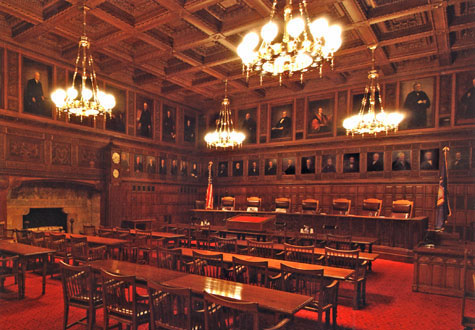New York has announced seven potential replacements for the Court of Appeals seat vacated by Judge Susan Read, who retired this year. And New York’s judicial selection for its highest court — and the reason that I write — looks nothing like the potential nominees for Supreme Court of the United States.
As previously noted here when discussing Court of Appeals nominees, I want to see practicing lawyers (or judges that used to be practicing lawyers) get elevated to the top bench. I want to see the same at SCOTUS, using a method I called the “tissue box test,” but that is never seen.
There is a stark disparity in the origins our our state/federal judiciary, which I discussed in 2011 by showing where each of them attended law school. The line-up at the time looked like this on SCOTUS — and it’s tough to miss the homogenous nature of the Harvard/Yale lineup:
Chief Judge John Roberts: Harvard Law School
Antonin Scalia: Harvard Law School
Anthony Kennedy: Harvard Law School
Clarence Thomas: Yale Law School
Ruth Bader Ginsburg: Harvard Law School
Stephen Breyer: Harvard Law School
Samuel Alito: Yale Law School
Sonia Sotomayor: Yale Law School
Elena Kagan: Harvard Law School
But it looked like this on New York’s top court:
Chief Judge Jonathan Lippmann: NYU Law School
Carmen Beauchamp Ciparick: St. John’s University School of Law
Victoria A. Graffeo: Albany Law School
Susan Phillips Read: University of Chicago Law School
Robert S. Smith: Columbia Law School
Eugene F. Pigott, Jr.: University at Buffalo Law School
Theodore J. Jones: St. Johns University School of Law
And what does the line-up of potential judges look like to replace Judge Read? Like this:
Michael J. Garcia, attorney in private practice (Kirkland & Ellis LLP) – Albany law School
Hon. Judith J. Gische, Associate Justice, Appellate Division, First Department; – SUNY, Buffalo
Caitlin J. Halligan, attorney in private practice (Gibson, Dunn & Crutcher LLP) – Georgetown
Hon. Erin M. Peradotto, Associate Justice, Appellate Division, Fourth Department – SUNY Buffalo
Benjamin E. Rosenberg, General Counsel, New York County District Attorney’ s Office – Harvard
Rowan D. Wilson, attorney in private practice (Cravath, Swaine & Moore, LLP) – Harvard
Stephen P. Younger, attorney in private practice (Patterson Belknapp Webb & Tyler LLP) – Albany Law School
One of the problems we currently have in SCOTUS selection is the part about them serving for a lifetime in the same seat. Presidents then try to pick young judges — late 40s or early 50s — that might sit on the bench for 20-30 years. Or potentially longer. With people living longer lifetimes, and slower turnover for a seat, the stakes have risen dramatically from the days the republic was founded. And there are plenty of people out there who think that should change.
Rather than the top court being the capstone of a long career, during which, hopefully, much was learned, it becomes the career itself and folks learn on the job.
But a 14-year term — which is what New York has — and a mandatory retirement age, leads to constantly changing seats. That leads to a different variety of judges, as we don’t have as much stake in any one judge as the federal equivalent.
While I limit myself here to an analysis of law schools — to the degree that this shows some variety — Scott Greenfield over at Simple Justice thinks there is not enough diversity, based instead on philosophy:
But in law, diversity isn’t built on gender or race, or ethnicity or ancestry. It’s built on legal philosophy, and legal experience. And what you don’t see are two things: lawyers who spent a day of their career working in the trenches on behalf of a criminal defendant, and lawyers who didn’t get a (often sizeable) paycheck from an employer.
There are many ways to view diversity, of course. Greenfield says that the lack of a criminal defense attorney or person with solo or small practice experience shows a lack of diversity. I, on the other hand, see the bar that SCOTUS has established with its Harvard/Yale fixation, and am happy to see that bar easily vaulted by people coming from diverse places.
This post isn’t about which New Yorker should sit on our high court, but rather, about the need for limitations on the power of any one individual. And that comes, in large part, from having a constantly changing dynamic bench from a diverse legal background instead of a stagnant one from a homogenous legal background. For the stagnant homogeneous ones attain too much power.
